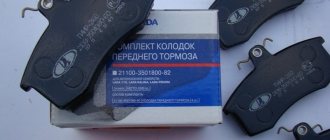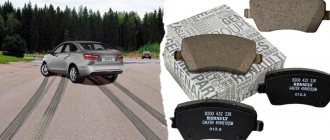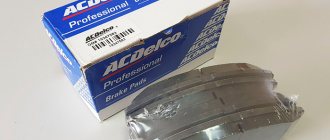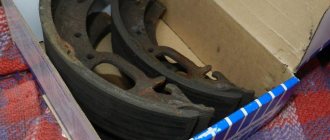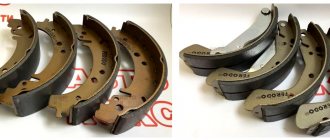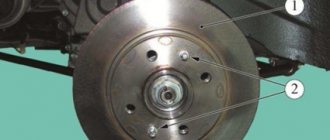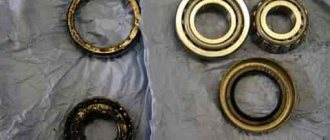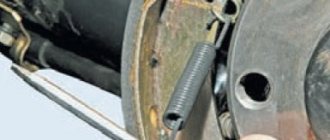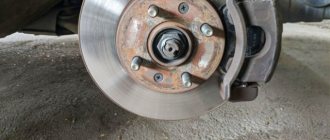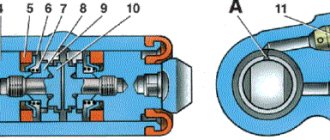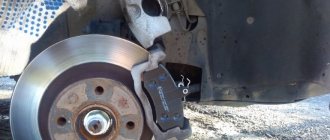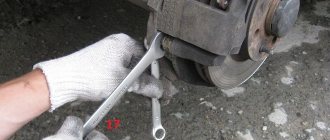Lada Priora is from the C-class family of cars, the official premiere of which took place in 2007. The car is built on the Lada (VAZ) 2110 platform. The company's engineers gave the car a fairly rigid body, which significantly improved not only handling, but also safety in general. The car is also equipped with additional options, for example: an airbag for the front passenger, a brake assist function (BAS), an anti-lock brake system (ABS), a central locking system that can be controlled remotely, and rain and light sensors were also installed on the car.
As for the other technical characteristics, the Lada Priora has a standard brake mechanism, that is, the front pads are disc and the rear pads are drum. It should be noted that the catalog numbers of the brake pads on the car are similar to those offered for the Lada Kalina car. Modifications with catalog numbers are presented below: front disc brake pads - 11180-3501080-00 , rear drum brake pads - 21080-3502090-01 and, accordingly, rear drum brake pads (ABS) - 11180-3502090-10 .
The difference between the rear drum pads, those with an anti-lock brake system (ABS) and those that do not, is that if it is installed, then the pads have special holes for the sensor. I would like to note that replacing the front and rear brake pads is absolutely the same, but if ABS is installed, then the sensor for it will need to be removed.
I would like to highlight another important point that buyers of Lada Priora cars in most cases purchase non-original brake pads, but copies of them. There are such analogues of the original pads as: Ferodo, TRW and Ate, if you need to buy something economical, then the most suitable company is BM and Pilenga.
Front disc brake pads
Front disc brake pads for the Lada Priora have the following dimensions: length – 104.4 mm, width – 62.1 mm and thickness – 17 mm. The cost of brake pads from different companies varies accordingly; it varies from 363-780 rubles.
I would also like to note that there are some points in the reviews about brake pads. Ferodo brake pads differ from each other in the color scheme of the packaging, there are red and green. The pads from Ferodo Premier, those that are red, are better than others, they are much stiffer, and their developer presents them in the comfort class segment. In turn, the manufacturer Ferodo Target produces other pads, their packaging is green, they are quite soft, and they work worse, but there is one plus that the brake disc will not be damaged as a result of braking.
Snapshot
Through the caliper window we estimate the thickness of the brake pads.
Through the caliper window we estimate the thickness of the brake pads.
Through the caliper window we estimate the thickness of the brake pads.
We replace the brake pads of both front wheels if the thickness of the friction lining has reached the maximum permissible value - 1.5 mm. Rotating the brake disc, inspect its working surfaces on both sides. There should be no cracks or deep grooves on the working surfaces of the disc.
Rear drum brake pads
Rear drum brake pads for the Lada Priora have the following dimensions: diameter – 200 mm, width – 41 mm. Prices for brake pads start from 460-860 rubles.
To summarize, it must be said that many car enthusiasts complain about the quality of the original pads and they want to replace them with better analogues that can be bought from companies such as Ate, TRW, Ferodo, Bosh and others. If the buyer wants to save significantly on his purchase, then he can take goods from BM or Pilenga.
It should be clarified that the mileage of the rear brake pads is on average 30,000 km longer than the front ones. You also need to take into account that driving style and the material of the friction linings may be different, so there is no exact date for replacement, generally it is about 30-50 thousand km for the front pads, and 60-90 thousand km for the rear pads.
1200 rub. for the photo report
We pay for photo reports on car repairs. Earnings from 10,000 rubles/month.
Write:
Lada Priora has a classic division of brake mechanisms - front disc and rear drum. Moreover, the catalog numbers of the brake pads on the Priora are identical to those offered for the second generation Lada Kalina. Here they are:
- front disc brake pads - 11180-3501080-00;
- rear drum brake pads - 21080-3502090-01;
- rear drum brake pads (ABS) - 11180-3502090-10.
The difference between rear drum pads without ABS (anti-lock brake system) and with it is that the latter have special holes for the sensor . In general, the procedure for replacing the rear brake pads is the same for both options, you just need to remove the ABS sensor (one screw) and do not forget about the master disc during reassembly.
Another rather important point is that Lada Priora owners often buy analogue brake pads, rather than the original, which loses in the price/quality competition. To replace the original, it is most often recommended to use TRW, Ate or Ferodo pads, but at the same time, products from Pilenga and BM are more popular on Priora.
Peculiarities
The first step is to remove the rear wheel and fix the car. If the vehicle is equipped with an anti-lock braking system, then the rear brakes have design features, and this must be taken into account. On a car with ABS, disconnect the wheel speed sensor from the brake shield. This is done so as not to damage the sensor or wiring. Under the drum there is a master disk for the ABS sensor. How to dismantle it? Remove the sensor using the E8 head.
Adjusting the handbrake of Lada Priora with your own hands
We turn the adjusting nut clockwise, thereby tightening the handbrake cables. The full stroke of the handbrake lever should be from 2 to 4 teeth (clicks). When the handbrake is adjusted correctly, with the handbrake lever lowered, the wheels should rotate freely. After adjustment, use the locknut to fix the adjusting nut.
This completes the replacement of the rear pads on the Priora and the adjustment of the handbrake. If you have any questions, ask them in the comments.
Vehicle preparation and tools
Before you start replacing the rear pads with your own hands, you need to prepare a tool. We will need:
- a set of standard keys;
- minus and Phillips screwdriver;
- pliers;
- wooden mallet or rubber mallet;
- metal brush;
- Additionally, you can get graphite lubricant, VD-40 fluid and a special hook for removing the tension springs.
Snapshot2
Brake mechanism of the left front wheel: 1 - screw securing the cylinder body to the caliper;
2 — brake hose; 3 — wheel cylinder; 4 — hydraulic brake bleeder fitting; 5 — caliper; 6 — brake pads; 7 - guide pin; 8 — guide pin cover; 9 — pad guide; 10 — brake disc; 11 — brake mechanism shield; 12 — ring gear for ABS sensor; 13 — locking plate; 14 - bolt securing the cylinder to the guide pin. Brake mechanism of the left front wheel: 1 - screw securing the cylinder body to the caliper; 2 — brake hose; 3 — wheel cylinder; 4 — hydraulic brake bleeder fitting; 5 — caliper; 6 — brake pads; 7 - guide pin; 8 — guide pin cover; 9 — pad guide; 10 — brake disc; 11 — brake mechanism shield; 12 — ring gear for ABS sensor; 13 — locking plate; 14 - bolt securing the cylinder to the guide pin.
Brake mechanism of the left front wheel: 1 - screw securing the cylinder body to the caliper; 2 — brake hose; 3 — wheel cylinder; 4 — hydraulic brake bleeder fitting; 5 — caliper; 6 — brake pads; 7 - guide pin; 8 — guide pin cover; 9 — pad guide; 10 — brake disc; 11 — brake mechanism shield; 12 — ring gear for ABS sensor; 13 — locking plate; 14 - bolt securing the cylinder to the guide pin.
Attention! The brake pads of the front wheels must be replaced as a set - all four pads. Replacing the pads of only one brake mechanism can lead to the car pulling to the side when braking.
If the fluid level in the brake hydraulic reservoir is at the MAX mark, then before installing new pads, use a syringe or a rubber bulb to pump out some of the liquid from the reservoir so that when the piston is recessed into the wheel cylinder of the brake mechanism, liquid does not flow out from under the reservoir cap.
After removing the front wheel, we securely fix the car on a factory-made support stand.
Snapshot9
We insert a screwdriver with a wide blade or a mounting spade through the caliper window and, resting it on the brake disc, move the bracket, recessing the piston into the cylinder.
We insert a screwdriver with a wide blade or a mounting spade through the caliper window and, resting it on the brake disc, move the bracket, recessing the piston into the cylinder.
We insert a screwdriver with a wide blade or a mounting spade through the caliper window and, resting it on the brake disc, move the bracket, recessing the piston into the cylinder.
After replacing the pads, press the brake pedal several times to set the gaps between the pads and discs. We check the fluid level in the tank and, if necessary, bring it up to normal.
During operation, the surface of the brake disc becomes uneven, as a result of which the contact area of the new, not yet worn-in pads with the disc decreases. Therefore, during the first 100 km after replacing the pads, until the new pads have broken in, be careful, as the car’s braking distance may increase. In this case, the pads may become hotter than usual, up to the appearance of slight smoke and odor, especially in hot weather.
Lada Priora: checking and replacing the brake pads of the front wheels
see also
Comments 47
When the Byda Priora with abs back only installed the factory ones, but now the Lada-Sport pads in front are factory, everything slows down, nothing creaks. I also installed Nippon, Ferodo, Ferodo, I remember it was terribly warm with them, they were too hard apparently.
I installed the standard ones. They squeak like an old UAZ, they eat up the disc, but they brake well.
